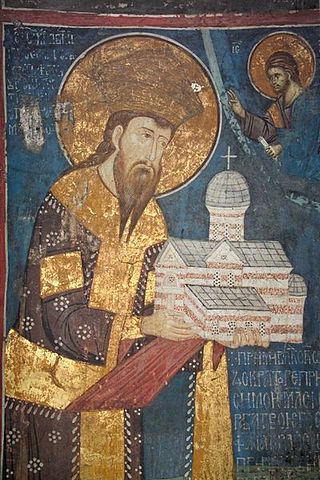
Mass is the main Eucharistic liturgical service in many forms of Western Christianity. The term Mass is commonly used in the Catholic Church, Western Rite Orthodoxy, Old Catholicism, and Independent Catholicism. The term is also used in some Lutheran churches, as well as in some Anglican churches, and on rare occasion by other Protestant churches.

An antiphon is a short chant in Christian ritual, sung as a refrain. The texts of antiphons are usually taken from the Psalms or Scripture, but may also be freely composed. Their form was favored by St Ambrose and they feature prominently in Ambrosian chant, but they are used widely in Gregorian chant as well. They may be used during Mass, for the Introit, the Offertory or the Communion. They may also be used in the Liturgy of the Hours, typically for Lauds or Vespers.

Mar Awgin or Awgen, also known as Awgin of Clysma or Saint Eugenios, was an Egyptian monk who, according to traditional accounts, introduced Christian monasticism to Syriac Christianity. These accounts, however, are all of late origin and often contain anachronisms. The historicity of Awgin is not certain.

The Armenian Rite is a liturgical rite used by both the Armenian Apostolic and the Armenian Catholic churches. Isaac of Armenia, the Catholicos of All Armenians, initiated a series of reforms with help from Mesrop Mashtots in the 5th century that distinguished Armenia from its Greek and Syriac counterparts. These reforms included a retranslation of the Bible and a revised liturgy. During the Crusades and afterwards, missionary activity by the Latin Church influenced liturgical norms and induced some Armenians to join the Catholic Church. The modern Armenian Rite features elements and interpolations from the Byzantine Rite and Latin liturgical rites, with the celebration of the Eucharist emulating the Liturgy of Saint Basil.

A customary is a Christian liturgical book containing the adaptation of a ritual family and rite for a particular context, typically to local ecclesiastical customs and specific church buildings. A customary is generally synonymous to and sometimes constituent of a consuetudinary that contains the totality of the consuetudines—ceremonial forms and regulations—used in the services and community practices of a particular monastery, religious order, or cathedrals. The distinctive qualities of medieval liturgical uses are often described within customaries. In modern contexts, a customary may also be referred to as a custom book.

Geoffrey Wainwright was an English theologian. He spent much of his career in the United States and taught at Duke Divinity School. Wainwright made major contributions to modern Methodist theology and Christian liturgy, and played a significant role on producing the text Baptism, Eucharist and Ministry, as a member of the Faith and Order Commission of the World Council of Churches (WCC).

The Alexandrian rites are a collection of ritual families and uses of Christian liturgy employed by three Oriental Orthodox churches, and by three Eastern Catholic Churches.
Deutsche Messe was published by Martin Luther in 1526. It followed his work Formula missae from the year 1523, pertaining to the celebration of a Latin mass. Both of these masses were meant only as suggestions made on request and were not expected to be used exactly as they were, but could be altered. The function of the mass, according to Luther, is to make people hear the word.
South Asia Theological Research Institute (SATHRI) was established by the Board of Theological Education of the Senate of Serampore College (BTESSC) in the year 1989. It is located at Mack House Complex in Serampore.

Ktetor or ktitor, meaning 'founder', is a title given in the Middle Ages to the provider of funds for construction or reconstruction of an Eastern Orthodox church or monastery, for the addition of icons, frescos, and other works of art. It was used in the Byzantine sphere. A Catholic equivalent of the term is donator. At the time of founding, the ktetor often issued typika, and was illustrated on frescoes. The female form is ktetorissa or ktitoritsa.
Eric J. Lott is a religious scholar who taught in Andhra Pradesh and Karnataka. Of the Indian languages, he knew Sanskrit, Telugu and Kannada.

Las arras, or las arras matrimoniales are wedding paraphernalia used in Christian wedding ceremonies in Spain, Latin American countries, and the Philippines. The tradition is also followed, with varying names and customs, in other countries and communities bearing degrees of Hispanic influence. Traditionally, in Spain and Latin America, it is made up of thirteen gold coins presented in an ornate box or chest; in the Philippines, it is in an ornate basket or pouch. After being blessed by a priest, they are given or presented by the groom to the bride.

The Lima Liturgy is a Christian ecumenical Eucharistic liturgy. It was written for the 1982 Plenary Session of the Faith and Order Commission of the World Council of Churches (WCC) in Lima, Peru and reflects the theological convergences of the meeting's Baptism, Eucharist and Ministry (BEM) document as expressed in liturgy. The liturgy was used again at the closing of a 1982 meeting of the Central Committee of the WCC in Geneva, Switzerland, in 1983 during the Sixth Assembly of the WCC in Vancouver, Canada, in 1991 at the Seventh Assembly of the WCC in Canberra, Australia, and, albeit unofficially, in 1993 at the fifth world conference on Faith and Order in Santiago de Compostela, Spain. Although the Eucharist has not been celebrated at WCC Assemblies after 1991 using the Lima or any other liturgy, the Lima Liturgy has been used in ecumenical events all over the world. For instance, many churches in North America use it on World Communion Sunday.

The 1604 Book of Common Prayer, often called the Jacobean prayer book or the Hampton Court Book, is the fourth version of the Book of Common Prayer as used by the Church of England. It was introduced during the early English reign of James I as a product of the Hampton Court Conference, a summit between episcopalian, Puritan, and Presbyterian factions. A modest revision of the 1559 prayer book, the Jacobean prayer book became the basis of the 1662 Book of Common Prayer, a still-authorized liturgical book within the Church of England and global Anglicanism.
Hanānā or khnana is dust collected from the burial site of a Christian saint or martyr for veneration or consumption. In the East Syriac Rite liturgies of Nestorian Christianity and successor denominations such as the Assyrian Church of the East, hanānā is used in both the anointing of the sick and Mystery of Crowning. Among Assyrian, Ethiopian, and early Latin Christians, the dust of holy persons was associated with healing powers.

Since the 18th century, there have been several editions of the Book of Common Prayer produced and revised for use by Unitarians. Several versions descend from an unpublished manuscript of alterations to the Church of England's 1662 Book of Common Prayer originally produced by English philosopher and clergyman Samuel Clarke in 1724, with descendant liturgical books remaining in use today.

The Oxford Guide to the Book of Common Prayer: A Worldwide Survey is a nonfiction reference work edited by Charles Hefling and Cynthia Shattuck which was published by Oxford University Press in 2006. The volume covered the development of the Book of Common Prayer as the dominant liturgical book of Anglicanism from the prayer book's origins in 16th-century England through to its global use and influence in the modern era, including coverage of the prayer book's influence on non-Anglican Christians. It was composed by 58 authors and was divided into more than 70 essays.

Free and Candid Disquisitions is a 1749 pamphlet written and compiled by John Jones, a Welsh Church of England clergyman, and published anonymously. The text advocated for reforming the Church of England to enable the reintegration of independent English Protestants, particularly through changes to the liturgies of the mandated 1662 prayer book.
Geoffrey John Cuming was a Church of England clergyman, liturgist, and music historian. After being permanently injured during his British Army service prior to the Battle of Arnhem, Cuming was ordained a priest and wrote several historical texts. He was an editor of the 1952 World's Encyclopedia of Recorded Music, a major discography. On Christian liturgy, Cuming's work included The Durham Book on John Cosin's 17th-century proposed liturgy and A History of Anglican Liturgy. His works on Early Christian liturgies included collaboration with Ronald Jasper and a posthumously published text on the Liturgy of Saint Mark. Cuming was an advisor to the Church of England's committees charged with producing new liturgical texts which produced the Alternative Service series, Alternative Service Book, and Common Worship. He also served as an editorial secretary for the Alcuin Club, vice-principal at St John's College, Durham, and on the faculty of both Ripon College Cuddesdon and the Church Divinity School of the Pacific.
Karen B. Westerfield Tucker is an American historian and United Methodist minister. She has authored several histories of Christian liturgy which were published in The Oxford Guide to the Book of Common Prayer and The Oxford History of Christian Worship; she also edited the latter volume with Geoffrey Wainwright. Westerfield Tucker was the president of the ecumenical liturgiological organization Societas Liturgica and was the editor-in-chief of its journal, Studia Liturgica. She is the Professor of Worship at the Boston University School of Theology.














